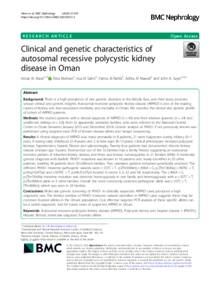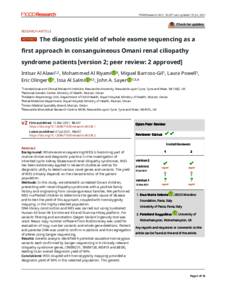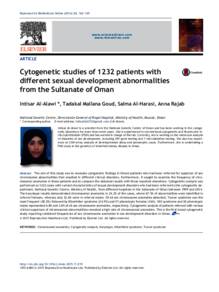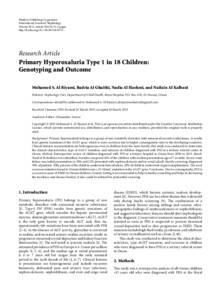وثيقة
Clinical and genetic characteristics of autosomal recessive polycystic kidney disease in Oman.
المعرف
DOI: 10.1186/s12882-020-02013-2
المصدر
BMC Nephrology. v. 21, 1, 347
المساهمون
Molinari, Elisa., مؤلف
Al-Salmi, Issa., مؤلف
Al-Rahbiyah, Fatma., مؤلف
Al-Mawaliyah, Adhra., مؤلف
Sayer, John A., مؤلف
الدولة
United Kingdom.
مكان النشر
London
الناشر
BioMed Central.
ميلادي
2020-08-14
اللغة
الأنجليزية
الملخص الإنجليزي
Background: There is a high prevalence of rare genetic disorders in the Middle East, and their study provides unique clinical and genetic insights. Autosomal recessive polycystic kidney disease (ARPKD) is one of the leading causes of kidney and liver-associated morbidity and mortality in Oman. We describe the clinical and genetic profile of cohort of ARPKD patients. Methods: We studied patients with a clinical diagnosis of ARPKD (n = 40) and their relatives (parents (n = 24) and unaffected siblings (n = 10)) from 32 apparently unrelated families, who were referred to the National Genetic Centre in Oman between January 2015 and December 2018. Genetic analysis of PKHD1 if not previously known was performed using targeted exon PCR of known disease alleles and Sanger sequencing. Results: A clinical diagnosis of ARPKD was made prenatally in 8 patients, 21 were diagnosed during infancy (0-1 year), 9 during early childhood (2-8 years) and 2 at later ages (9-13 years). Clinical phenotypes included polycystic kidneys, hypertension, hepatic fibrosis and splenomegaly. Twenty-four patients had documented chronic kidney disease (median age 3 years). Twenty-four out of the 32 families had a family history suggesting an autosomal recessive pattern of inherited kidney disease, and there was known consanguinity in 21 families (66%). A molecular genetic diagnosis with biallelic PKHD1 mutations was known in 18 patients and newly identified in 20 other patients, totalling 38 patients from 30 different families. Two unrelated patients remained genetically unsolved. The different PKHD1 missense pathogenic variants were: c.107C > T, p.(Thr36Met); c.406A > G, p.(Thr136Ala); c.4870C > T, p.(Arg1624Trp) and c.9370C > T, p.(His3124Tyr) located in exons 3, 6, 32 and 58, respectively. The c.406A > G, p.(Thr136Ala) missense mutation was detected homozygously in one family and heterozygously with a c.107C > T, p.(Thr36Met) allele in 5 other families. Overall, the most commonly detected pathogenic allele was c.107C > T; (Thr36Met), which was seen in 24 families. Conclusions: Molecular genetic screening of PKHD1 in clinically suspected ARPKD cases produced a high diagnostic rate. The limited number of PKHD1 missense variants identified in ARPKD cases suggests these may be common founder alleles in the Omani population. Cost effective targeted PCR analysis of these specific alleles can be a useful diagnostic tool for future cases of suspected ARPKD in Oman.
ISSN
1471-2369
URL المصدر
قالب العنصر
مقالات الدوريات




